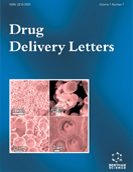Abstract
Growing demands on a suitable formulation method that ensures the stability of the active compound coupled with the limitations of current methods (milling, lyophilization, spray drying, and freeze spray drying) has brought wide attention to supercritical fluid (SCF) technology. Advantages of using the SCF technology comprise its high abilities, adaptability in providing alternative processing methods, high compressibility and diffusivity of the supercritical fluid, capability as an alternative for conventional organic solvents, and the option to attain different processing parameters which would be otherwise difficult to conduct with traditional methods. This review proposes to present an up-to-date outlook on dry powder pulmonary formulations of macromolecules using SCF technology.
Keywords: Dry powder, super critical fluid, protein, microparticles, peptide, macromolecules, SCF, Anaemia, Encapsulation of Insulin, POWDER INHALATION, inhalation
Drug Delivery Letters
Title: Recent Advances Using Supercritical Fluid Techniques for Pulmonary Administration of Macromolecules via Dry Powder Formulations
Volume: 1 Issue: 2
Author(s): Iman M. Al-fagih, Fars K. Alanazi, Gillian A. Hutcheon and Imran Y. Saleem
Affiliation:
Keywords: Dry powder, super critical fluid, protein, microparticles, peptide, macromolecules, SCF, Anaemia, Encapsulation of Insulin, POWDER INHALATION, inhalation
Abstract: Growing demands on a suitable formulation method that ensures the stability of the active compound coupled with the limitations of current methods (milling, lyophilization, spray drying, and freeze spray drying) has brought wide attention to supercritical fluid (SCF) technology. Advantages of using the SCF technology comprise its high abilities, adaptability in providing alternative processing methods, high compressibility and diffusivity of the supercritical fluid, capability as an alternative for conventional organic solvents, and the option to attain different processing parameters which would be otherwise difficult to conduct with traditional methods. This review proposes to present an up-to-date outlook on dry powder pulmonary formulations of macromolecules using SCF technology.
Export Options
About this article
Cite this article as:
M. Al-fagih Iman, K. Alanazi Fars, A. Hutcheon Gillian and Y. Saleem Imran, Recent Advances Using Supercritical Fluid Techniques for Pulmonary Administration of Macromolecules via Dry Powder Formulations, Drug Delivery Letters 2011; 1 (2) . https://dx.doi.org/10.2174/2210304x11101020128
| DOI https://dx.doi.org/10.2174/2210304x11101020128 |
Print ISSN 2210-3031 |
| Publisher Name Bentham Science Publisher |
Online ISSN 2210-304X |
 6
6
- Author Guidelines
- Bentham Author Support Services (BASS)
- Graphical Abstracts
- Fabricating and Stating False Information
- Research Misconduct
- Post Publication Discussions and Corrections
- Publishing Ethics and Rectitude
- Increase Visibility of Your Article
- Archiving Policies
- Peer Review Workflow
- Order Your Article Before Print
- Promote Your Article
- Manuscript Transfer Facility
- Editorial Policies
- Allegations from Whistleblowers
Related Articles
-
Ras Family Small GTPase-Mediated Neuroprotective Signaling in Stroke
Central Nervous System Agents in Medicinal Chemistry Neuroimmune Aspects of Sjogren`s Syndrome: Role of VIP/VPAC System in Immune and Salivary Gland Epithelial Cell Function
Current Pharmaceutical Design Alsevirone-NF Reduces Serum Testosterone and Inhibits Prostate Cancer Xenograft Growth in Balb/c Nude Mice
Clinical Cancer Drugs Surgical Strategies for Fertility Preservation in Women with Cancer
Current Women`s Health Reviews The University of New Mexico Center for Molecular Discovery
Combinatorial Chemistry & High Throughput Screening TRP Channels as A Newly Emerging Non-Voltage-Gated Ca2+ Entry Channel Superfamily
Current Pharmaceutical Design Anti-Inflammatory Approaches that Target the Chemokine Network
Recent Patents on Inflammation & Allergy Drug Discovery Patent Selections:
Recent Patents on Anti-Cancer Drug Discovery Potential Interactions between miRNAs and Hypoxia: A New Layer in Cancer Hypoxia
Anti-Cancer Agents in Medicinal Chemistry Subject Index To Volume 12
Current Pharmaceutical Design Update of QSAR & Docking & Alignment Studies of the DNA Polymerase Inhibitors
Current Bioinformatics PET with Non-Standard Nuclides
Current Topics in Medicinal Chemistry The Induction and Repair of DNA Interstrand Crosslinks and Implications in Cancer Chemotherapy
Anti-Cancer Agents in Medicinal Chemistry Cancer Diagnosis and Treatment Guidance: Role of MRI and MRI Probes in the Era of Molecular Imaging
Current Pharmaceutical Biotechnology Growth Responses Following a Single Intra-Muscular hGH Plasmid Administration Compared to Daily Injections of hGH in Dwarf Mice
Current Gene Therapy Erythropoietin Withdrawal Leads to the Destruction of Young Red Cells at the Endothelial-Macrophage Interface
Current Pharmaceutical Design Model Checking a Synchronous Diabetes-Cancer Logical Network
Current Bioinformatics Accelerator Production of Scandium Radioisotopes: Sc-43, Sc-44, and Sc-47
Current Radiopharmaceuticals Antagonizing IL-6 in Ankylosing Spondylitis: A Short Review
Inflammation & Allergy - Drug Targets (Discontinued) Jurisprudence Study of Muslim Rules and Effects of Ovarian Transplants in Women with Infertility; A Review
Current Women`s Health Reviews


























